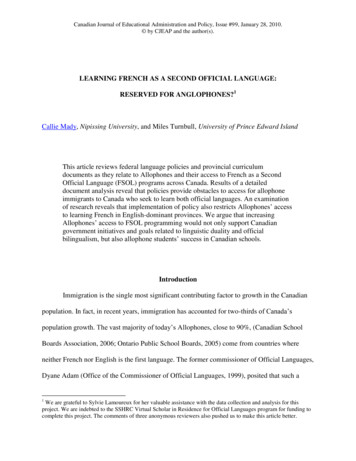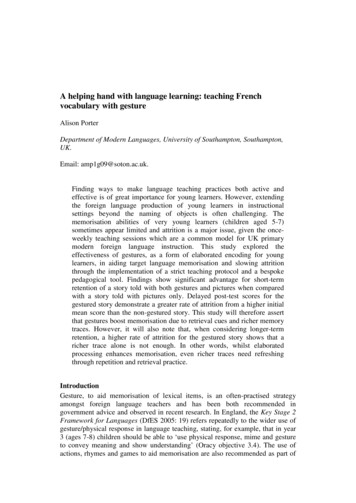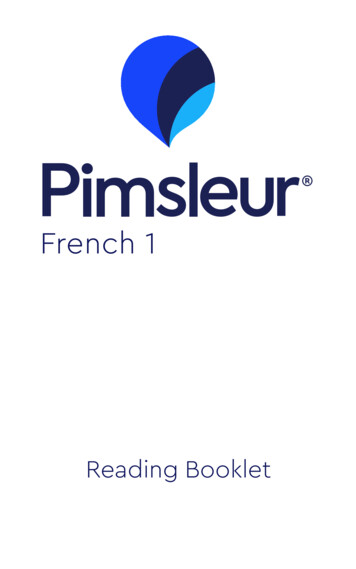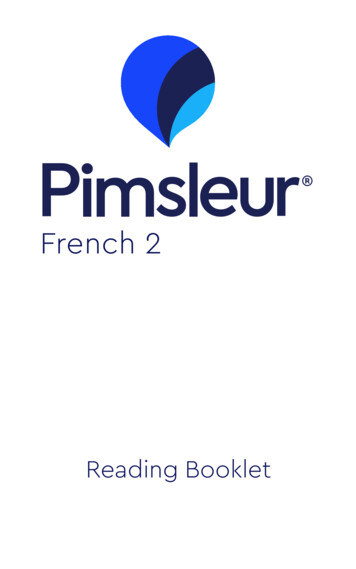
Transcription
Canadian Journal of Educational Administration and Policy, Issue #99, January 28, 2010. by CJEAP and the author(s).LEARNING FRENCH AS A SECOND OFFICIAL LANGUAGE:RESERVED FOR ANGLOPHONES?1Callie Mady, Nipissing University, and Miles Turnbull, University of Prince Edward IslandThis article reviews federal language policies and provincial curriculumdocuments as they relate to Allophones and their access to French as a SecondOfficial Language (FSOL) programs across Canada. Results of a detaileddocument analysis reveal that policies provide obstacles to access for allophoneimmigrants to Canada who seek to learn both official languages. An examinationof research reveals that implementation of policy also restricts Allophones’ accessto learning French in English-dominant provinces. We argue that increasingAllophones’ access to FSOL programming would not only support Canadiangovernment initiatives and goals related to linguistic duality and officialbilingualism, but also allophone students’ success in Canadian schools.IntroductionImmigration is the single most significant contributing factor to growth in the Canadianpopulation. In fact, in recent years, immigration has accounted for two-thirds of Canada’spopulation growth. The vast majority of today’s Allophones, close to 90%, (Canadian SchoolBoards Association, 2006; Ontario Public School Boards, 2005) come from countries whereneither French nor English is the first language. The former commissioner of Official Languages,Dyane Adam (Office of the Commissioner of Official Languages, 1999), posited that such a1We are grateful to Sylvie Lamoureux for her valuable assistance with the data collection and analysis for thisproject. We are indebted to the SSHRC Virtual Scholar in Residence for Official Languages program for funding tocomplete this project. The comments of three anonymous reviewers also pushed us to make this article better.
Learning French as a Second Official Languagediverse influx of immigrants presents a challenge to the linguistic duality of Canada—one of thefederal government’s identified characteristics of Canadian identity. Yet, voices from thosediverse groups heard in two discussion forums offered by the present Commissioner of OfficialLanguages, Graham Fraser, suggest that the challenge to official language duality comes notfrom the groups themselves, as they support official language duality, but from the lack of accessto French-language learning opportunities in English-dominant areas across Canada (Office ofthe Commissioner of Official Languages, 2007). The majority of the participating focus groupsidentified official language bilingualism as a Canadian value that was complementary to culturaldiversity. The participant groups acknowledged official language bilingualism as advantageousfor the allophone community to enhance integration, social and economic mobility, and citizenparticipation.This article provides a review and an analysis of current federal language policies,provincial and territorial curriculum documents, and their implementation across Canada as theyrelate to Allophones and their access to in-school French-language learning opportunities.English and French second official language documents are examined for specific attention givento allophone issues. In particular, English and French second official language documents fromEnglish-dominant provinces were examined with respect to references to the inclusion orexclusion of allophone students in second official language study. In areas where learning Frenchis obligatory at school and there is a great influx of immigrants in this area, our analyses revealthat allophone students are often excluded from in-school French-language learningopportunities. This exclusion may prevent Allophones from developing knowledge of both ofCanada’s official languages, whereas the potential exists for them to not only support linguisticduality and bilingualism but also derive personal benefit from the economic and socio-cultural2
Learning French as a Second Official Languageopportunities provided by official language bilingualism. Multilingual acquisition theory(Aronin, 2005; Cenoz, 2003) and empirical studies in the field of multilingualism (Griessler,2001; Keshavarz & Astaneh, 2004) lend support to the principle that bilinguals have advantagesin additional language learning. Within the Canadian context, Mady (2007) showed thatallophone students outperformed Canadian-born students on a number of measures of Frenchproficiency despite their more limited exposure to French. With a similar allophone population,Carr (2009) demonstrated that Allophones’ knowledge of French positively impacted theirlearning of English. Such academic benefits are of particular importance given Allophones’struggles in other areas of the curriculum (Simons & Connelly, 2000). Inclusion of Allophones inin-school French-language learning opportunities could also provide for the integration of two ofCanada’s distinguishing features: linguistic duality and cultural diversity.For the purpose of this paper, the following definitions are used:Allophone: a person who comes to live in Canada, as an immigrant or refugee,with a first language that is neither of Canada’s official languages. For this paper,we consider allophone students who arrive in Quebec and study French as thedominant language and English as a second official language, and allophonestudents who arrive in English-dominant regions and study English as thedominant language and French as a second official language.Core French: French as a second official language taught as a subject for oneperiod each day, or a few times a week. Known as basic French in Manitoba andFSOL in British Columbia and Alberta.French as a second official language: The term French as a second officiallanguage has been chosen to denote the fact that, in English-dominant Canada,many learners learn French as their second official language even though it maybe the second, third or fourth languages they have learned.French Immersion: A program delivery model where French is the language ofinstruction for a significant part of the school day.3
Learning French as a Second Official LanguageMethodSince language policy in Canada falls under federal jurisdiction and educational policyfalls under provincial and territorial jurisdiction, federal, provincial and territorial documentswere analysed for the purpose of this paper. Federally, publications from the Commissioner ofOfficial Languages, Canadian Department of Heritage and its Official Languages in Educationprogram were analysed. Provincial and territorial French as a Second Official Language (FSOL)and English as a Second Official Language (ESOL) curriculum documents were analysed forreference to Allophones in French-language learning opportunities. Standard document analysismethods (Denzin & Lincoln, 2005, p. 782) were employed. References to Allophones wereidentified in the FSOL documents using the following keywords: Allophones, English as aSecond Language, English as an Additional Language, English language learners, immigrants,and new Canadians. References to French-language learning as it pertains to Allophones in theFSOL documents were identified using the following key words: French, second languagelearning, and additional language learning. Qualitative content analysis was applied to allexcerpts of the texts identified.FindingsFederal PolicyLanguage policy in Canada is created federally. In recognition of the importance oflanguage in building national solidarity and identity, the federal government passed The OfficialLanguages Act (1969), an outcome of The Royal Commission on Bilingualism and Biculturalismthat recognized equality of status for French and English in Canada. The overall goal of grantingthis equality status was to protect linguistic minority communities in Canada. Whereas the Act4
Learning French as a Second Official Languagedid not address the spread of French and English in itself, the federal government, through TheDepartment of Canadian Heritage, established the Official Languages in Education program(1970) to financially support provincial and territorial efforts to enhance second official languagelearning opportunities. Federal recognition of the importance of education in the spread ofCanada’s official languages remains pertinent as revealed in the federal government’s policystatement The Next Act: New Momentum for Canada’s Linguistic Duality (2003). In support ofsecond official language learning, the federal government increased funding to the provinces andterritories with a view to doubling the proportion of secondary school graduates with a functionalknowledge of their second official language. With this goal in mind, the funds were targeted toimprove core French/English, revitalize immersion, provide bilingual graduates the opportunityto put their skills to good use, and increase the number of qualified teachers for official languageeducation. The federal government has since reiterated its commitment to and financial supportfor official language learning in The Roadmap for Canada's Linguistic Duality 2008-2013:Acting for the Future.This analysis of federal documents, from the foundation of the Official Languages Act tothe present, revealed that reference to opportunities for Allophones to learn both officiallanguages is absent. The Royal Commission on Bilingualism and Biculturalism (1967) and TheMulticulturalism Act (1985), for example, limited the government’s assistance to facilitateimmigrants’ learning of one of Canada’s official languages, but not both. In English Canada,immigrants must learn English, but their access to also learn French at school is not guaranteedby federal policy documents. Such limitations continue to this day; The Next Act, for example,limits its description of improved access to linguistic duality to Anglophones and Francophonesas it seeks to double the proportion of bilingual graduates.5
Learning French as a Second Official Language―Today, the proportion of bilingual Francophones and Anglophones in the 15 to 19 agegroup is around 24%. The objective of the Action Plan is to raise this proportion to 50% by2013‖ (Privy council, 2003, p. 27). Limiting official language bilingualism to Anglophones andFrancophones (disregarding Allophones) would make it difficult, if not impossible, to double theproportion of students studying French. Moreover, The Roadmap for Canada’s LinguisticDuality 2008-2013 (Department of Canadian Heritage, 2008), does not address any more clearlythan previous policy whether allophone students may be required to or encouraged to study bothofficial languages. Given that the federal government claims that linguistic duality is part of theCanadian identity, it is surprising that it does not explicitly include Allophones in policy onsecond official language learning. Similarly, given that the federal government states thatcultural diversity is also a core Canadian value, it is puzzling that it does not clearly encouragethe interaction of cultural diversity with linguistic duality.Such silence with regard to official language bilingualism for Allophones is contrary tothe federal commitment to promote linguistic duality and bilingualism particularly given that95% of allophone Canadians believe that it is important for their children to learn a languageother than English (Parkin & Turcotte, 2003). As it pertains to official language bilingualism inparticular, Allophones were more supportive of such bilingualism than Anglophones. Parkin andTurcotte linked Allophones’ support for official language bilingualism to their complementarysupport for multiculturalism. The federal government’s disregard for the allophone populationwith regard to official language bilingualism policy is especially perplexing given that this issuehas been explicitly highlighted by Canadian Commissioners of Official Languages. For example,Dyane Adam highlighted the need for the federal government to integrate linguistic duality andcultural diversity for the benefit of Allophones (Office of the Commissioner of Official6
Learning French as a Second Official LanguageLanguages, 2006). Similarly, the present Commissioner of Official Languages, Graham Fraser,recognizes the desire of Allophones to become official language bilingual and that in addition toencouraging a response to Adam’s 2006 recommendation, he encourages the federal governmentto place greater importance on promoting linguistic duality for newcomers to Canada. At present,it remains, as per this federal document analysis, that there are no federal policies or programsthat provide Allophones with the opportunity to learn both official languages.Provincial PoliciesWhile Canada is an officially bilingual country, all of its provinces and territories, withthe exception of New Brunswick, are not. As indicated above, language policy is createdfederally in Canada, while education (including the provision for classroom second languagelearning opportunities) is a provincial or territorial responsibility. With regard to in-schoolFrench-language learning opportunities in particular, French is an obligatory area of study in sixprovinces, but optional elsewhere. The analysis of FSOL and ESOL curriculum documents (seeTable for a summary of provincial and territorial FSOL policies across Canada) in the Englishdominant provinces and territories across Canada, including New Brunswick, revealed littlereference to and an absence of direct policies and specific programs that ensure allophonestudents’ access to learn FSOL.British Columbia and the Yukon. In British Columbia and the Yukon, all boards ofeducation must offer a second language (French being among those languages offered) fromGrades 5 to 8. According to their Language Education Policy (1997), all students must study asecond language; however, schools can choose to withdraw students and deny them access toFSOL p
Learning French as a Second Official Language 7 Languages, 2006). Similarly, the present Commissioner of Official Languages, Graham Fraser, recognizes the desire of Allophones to become official language bilingual and that in addition to encouraging a response to Adam’s 2006 recommendation, he encourages the federal government to place greater importance on promoting











